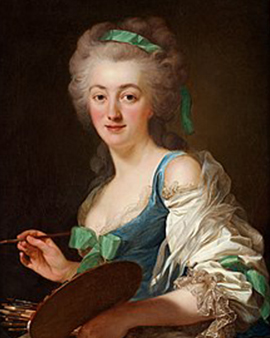Anne Vallayer-Coster, born in Paris on December 21, 1744, and died there on February 28, 1818, was a major figure on the French art scene. A talented painter and draftswoman, she gained recognition and success both before and after the French Revolution. Her impressive career was aided by the protection of Marie-Antoinette, who introduced her to the royal family, allowing her to paint portraits of some of its members.
Vallayer-Coster was born into a family of artists - her father Joseph Vallayer was a goldsmith and her mother Anne Cornut Delafontaine a miniature painter. She spent her childhood and adolescence at the Manufacture royale des Gobelins, where she had the privilege of being taught by renowned artists such as Madeleine Françoise Basseporte and Claude Joseph Vernet. Her first documented artistic works date back to 1762.
Thanks to her talent and skill in still life painting, she was admitted to the prestigious Académie royale de peinture et de sculpture in 1770. Her work in the following years until 1789, especially her regular exhibitions at the Salon, earned her praise and recognition from distinguished art critics such as Denis Diderot.
An important turning point in her career was the support she received from Marie-Antoinette beginning in 1772, when the dauphine and later queen allowed Vallayer-Coster to live in the prestigious Galerie du Louvre and paint portraits of members of the royal family.
In 1781, she married lawyer Jean-Pierre-Silvestre Coster, adding his last name to hers. Despite the turbulent times of the French Revolution, Vallayer-Coster continued her artistic activity, exhibiting again at the Salon from 1795.
Vallayer-Coster's work spanned a variety of media, including oil paintings, watercolors, pastels, gouaches, drawings, and miniatures. After the Revolution, tapestries were produced based on her designs. Her works enjoyed great popularity among contemporaries, including the Marquis de Marigny, Empress Josephine, Louis XVIII, and the Duchesse d'Angoulême.
Anne Vallayer-Coster was one of the few women to succeed in the arts of her time. She was in direct competition with important male artists of her time such as Cornelis van Spaendonck and Jean Baptiste Simeon Chardin. In fact, some of her works were mistakenly attributed to Chardin, and it is known that works by Vallayer-Coster were occasionally sold at auction as Chardin's works. Despite these confusions and the challenges she faced as a woman in an art world dominated by men, Vallayer-Coster left an impressive legacy and is considered one of the most important artists of her time. Her works can still be found in museums and collections around the world.
×





.jpg)
.jpg)
.jpg)
.jpg)
.jpg)
.jpg)
.jpg)
.jpg)
_-_(MeisterDrucke-1021246).jpg)
_-_(MeisterDrucke-1021246).jpg)
.jpg)
.jpg)
.jpg)
.jpg)
.jpg)
.jpg)
.jpg)
.jpg)
.jpg)
.jpg)
.jpg)
.jpg)
.jpg)
.jpg)
.jpg)
.jpg)
.jpg)
.jpg)
.jpg)
.jpg)
.jpg)
.jpg)
.jpg)
.jpg)
.jpg)
.jpg)
.jpg)
.jpg)
.jpg)
.jpg)
.jpg)
.jpg)






